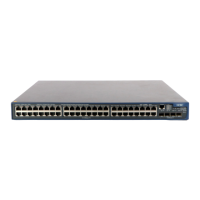Operation Manual – Multicast
H3C S3600 Series Ethernet Switches-Release 1510 Chapter 7 PIM Configuration
7-7
must be elected dynamically through the auto-election mechanism and BootStrap
router (BSR) must be configured.
BSR is the core management device in a PIM-SM network. It is responsible for:
z Collecting the Advertisement messages sent by the Candidate-RP (C-RP) in the
network.
z Selecting part of the C-RP information to form the RP-set, namely, the mapping
database between the multicast group and RP.
z Advertising the RP-set to the whole network so that all the routers (including DR)
in the network know the position of RP.
One or more candidate BSRs must be configured in a PIM domain. Through
auto-election, the candidate BSRs elect a BSR that is responsible for collecting and
advertising RP information. The auto-election among candidate BSRs is described in
the following section:
z Specify a PIM-SM-enabled interface when configuring a router as a candidate
BSR.
z Initially, each candidate BSR considers itself as the BSR of the PIM-SM and uses
the IP address of the specified interface as the BSR address to send Bootstrap
messages.
z When the candidate BSR receives Bootstrap messages from other routers, it
compares the BSR address in the received Bootstrap message with its own BSR
address by priority and IP address. If the priority is the same, the candidate BSR
with a higher IP address is considered to be better. If the former is better, the
candidate BSR replaces its own BSR address with the new BSR address and
does not consider itself as BSR any more. Otherwise, the candidate BSR keeps its
own BSR address and continues to consider itself as BSR.
Figure 7-4 shows the positions of RPs and BSRs in the network:
C-BSR
C-RP
C-RP
BSR
C-RP
BSR message
C-RP advertisement
Figure 7-4 Diagram for the communication between RPs and BSRs

